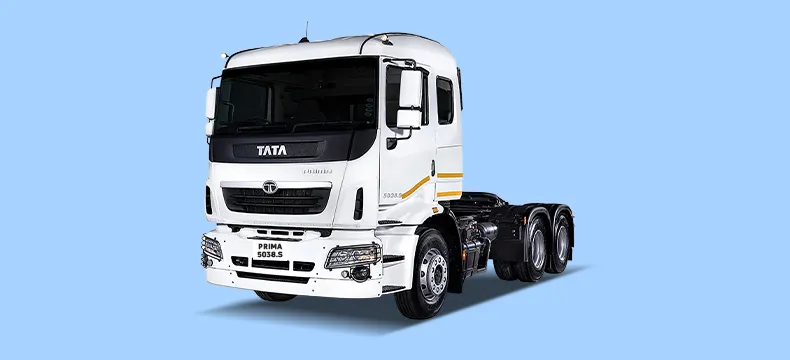4 Dec 2025

How Does the Tata LPT 810 Boost Fuel Efficiency in Urban Logistics?
- Tata Motors
- 23 Sep 2024
- COMMERCIAL VEHICLE
Introduction
As Kenya grows, its urban landscape also expands. In Kenya, 14.8 million people, or 31% of the population, reside in urban areas. Half of Kenya’s population is set to live in urban areas by 2033. This presents a huge business opportunity. Efficiently transporting goods to these densely populated urban areas would significantly boost your business.
Fuel is an important factor in improving efficiency in commercial vehicles, and it also has significant business implications. However, fuel is an expensive resource, and wanting to improve fuel efficiency for your fleet is a valid concern.
So, what are the key features to look for, and how does the Tata LPT 810 boost fuel efficiency?
Key Features Contributing to Fuel Efficiency
Several factors affect a truck’s fuel efficiency. Understanding them can help you choose the right truck for your business needs. These factors include:
- Powertrain:
The powertrain is one of the most significant factors in understanding a truck's fuel economy. All the various parts of the powertrain, from the rear axle to the oil used, contribute to fuel efficiency. Specific components with a comparatively larger impact include the engine and the gearbox. As a diesel vehicle, the Tata LPT's fuel efficiency tends to be better.
- Aerodynamics:
Trucks with more aerodynamic shapes tend to be more fuel-efficient than those with boxier designs. Performance can be affected by everything from external accessories to mirrors and front spoilers. Key features include cabin design, roof spoilers, cab side deflectors, chassis skirts, and fender flares.
- Rolling Resistance:
Rolling resistance is the force that resists forward motion as wheels roll over the road. Tires and wheel alignment mainly influence it. To minimize rolling resistance, use fuel-optimized tires, maintain proper pressure, and ensure correct alignment. Misalignment causes instability and increases fuel consumption, making tire pressure a critical factor in fuel efficiency.
- Transmission Type:
Automatic transmissions are generally less fuel-efficient than manual transmissions. For urban logistics, the Tata LPT 810 can be chosen as a manual truck.
- Weather:
Trucks generally experience worse fuel economy in cold weather. However, in Kenya's warmer climate, the main concern is air conditioning use, which can increase fuel consumption by up to 20% due to the extra load on the engine.
- Terrain:
Trucks tend to get worse fuel economy when driving in hilly or mountainous terrain. Thankfully, the urban areas of Kenya are relatively level. The Tata LPT 810 has a 30% maximum grade ability to ensure it can maneuver effectively across different terrains.
- Regular Maintenance:
Regular maintenance, such as oil changes and tune-ups, can help keep your truck running efficiently and improve fuel economy.
- Horsepower:
Horsepower (hp) is a significant factor in a vehicle’s fuel consumption. More power generally means higher fuel consumption. You can factor in fuel efficiency by choosing a truck with as much horsepower as you need.
Impact on Urban Logistics Operations with the Tata LPT 810
The Tata LPT 810 is designed to excel in urban logistics, offering superior fuel efficiency and performance. Its diesel engine, known for better fuel economy, significantly reduces operational costs. The truck's aerodynamic design enhances its efficiency, making it an ideal choice for city deliveries.
With a powerful engine delivering 125 hp at 2400 rpm, the Tata LPT 810 provides the correct horsepower for various business needs. The 4-cylinder, water-cooled turbo-intercooled engine and a GBS 550 6F + 1R gearbox ensure optimal power transmission, boosting the truck's overall performance and fuel efficiency.
The Tata LPT 810's manual transmission further enhances its fuel economy, making it a reliable option for businesses focused on cost-effective operations. With a specific X-Y km/hr mileage, the Tata LPT 810 is a dependable truck for urban logistics.
The Bottom Line
Knowing what you need from your vehicle is one of the most important factors in choosing a fuel-efficient truck that’s right for you. Various factors affect the fuel efficiency of commercial vehicles. The Tata LPT 810 has been thoughtfully crafted to provide customers maximum satisfaction. Urban logistics rely on multiple factors to succeed, including fuel efficiency.
Fuel efficiency reduces fuel costs, leading to higher savings, and it is also a key consideration from an environmental perspective. You should choose only the best for your business. You can also choose from other vehicles in the same category from the Tata Motors family, like the Ultra T.9 and the LPT 1216.
FAQs
What are the key features of the Tata LPT 810 that contribute to its fuel efficiency?
You should choose the Tata LPT 810 for urban logistics because many factors contribute to its great fuel efficiency, from its aerodynamic design to the powertrain, manual transmission, diesel use, and more!
How does the engine technology in the Tata LPT 810 improve fuel efficiency?
Diesel vehicles tend to be more fuel-efficient. The Tata LPT 810 has a 4-cylinder, in-line, water-cooled turbo-intercooled common rail direct injection diesel engine, making it an excellent pick for your business.
What role does the transmission system play in enhancing fuel efficiency?
Manual transmissions are more fuel-efficient than automatic transmissions, making the Tata LPT 810 an ideal addition to your business.
How does the aerodynamic design of the Tata LPT 810 contribute to fuel savings?
The eye-catching Tata LPT 810 has been designed with your needs in mind. From the cabin to the chassis, its thoughtfully crafted design ensures the perfect blend of aerodynamic efficiency and functional brilliance. The aerodynamics of truck design play a key role in fuel efficiency.
- Tags



















